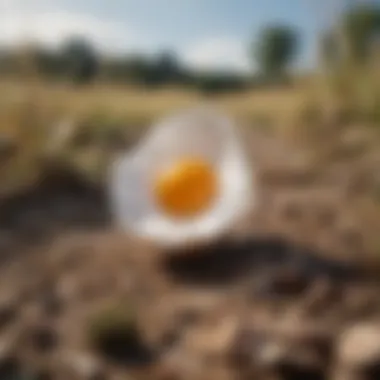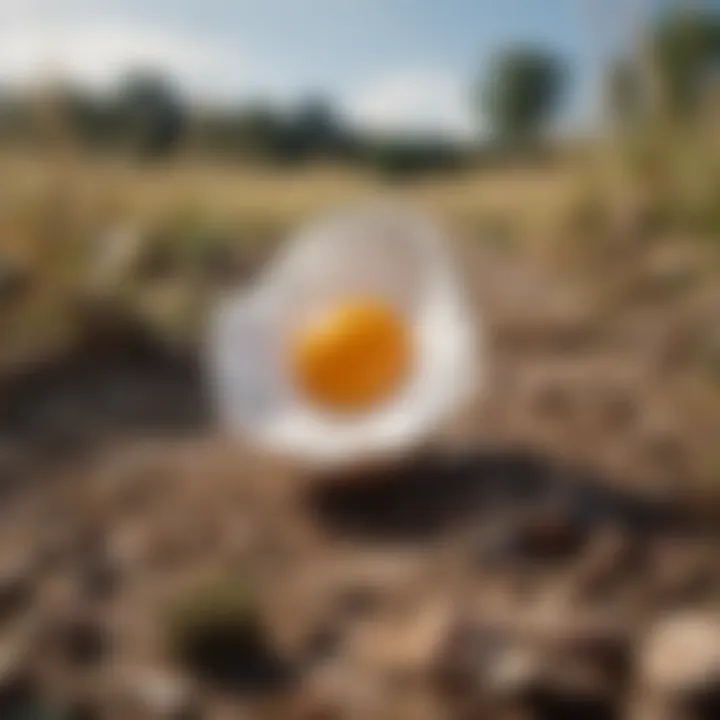Understanding Shell-less Egg Laying: Insights and Implications


Intro
The discussion surrounding shell-less egg laying is gaining traction across various biological and agricultural fields. This phenomenon raises essential questions about the underlying mechanisms that allow certain species to produce eggs without a protective shell. Such an anomaly not only challenges traditional understanding of reproductive biology but also opens avenues for new agricultural practices that could influence food production and sustainability.
In this article, we will delve into the complexity of shell-less egg laying. We aim to clarify the biological concepts underpinning this unusual trait, its ecological implications, and its applications in agriculture and aquaculture. By examining these aspects, we will reveal how understanding this phenomenon can lead to improved farming practices and better management of species exhibiting shell-less reproduction.
Overview of the Topic
Definition and Importance
Shell-less egg laying occurs when animals produce eggs that lack the typical calcareous shell. This feature is most commonly observed in specific reptilian species, but it also appears in certain birds and amphibians. The significance of this trait relates to its impact on species survival, adaptation, and reproduction. Recognizing the mechanisms behind shell-less reproduction can provide insights into evolutionary processes as well as potential benefits or drawbacks to farming practices.
Current Trends
Recent research indicates a rising interest in shell-less egg laying due to climate change, habitat loss, and other environmental pressures. Studies highlight factors such as temperature fluctuations and pollution that may contribute to the increase of shell-less egg occurrences. Understanding these trends is vital in addressing agricultural productivity and species conservation.
"Understanding the biological mechanics of shell-less eggs can lead to sustainable practices in farming, enhancing both productivity and environmental consciousness."
Key Techniques and Practices
Understanding the conditions and practices surrounding shell-less egg production is critical for both farmers and researchers. Below are some techniques and practices that can aid in managing these cases effectively.
Step-by-Step Guide
- Monitor Environmental Conditions: Regularly assess temperature, humidity, and pollution levels.
- Evaluate Health of Breeding Stock: Ensure that breeding animals are healthy. Nutritional deficiencies can influence egg production.
- Adjust Breeding Practices: Modify breeding times and conditions based on environmental assessments to promote normal egg formation.
Tools and Equipment Needed
- Thermometers for monitoring temperature
- Hygrometers for measuring humidity
- Nutritional supplements to ensure animal health
Challenges and Solutions
Common Obstacles
Managing shell-less egg laying presents several challenges. These include:
- Increased mortality rates of eggs due to lack of protection
- Difficulty in predicting breeding cycles
- Potential economic loss in agricultural ventures
Innovative Solutions
Farmers and researchers are finding ways to mitigate these challenges. Some solutions include:
- Experimenting with artificial incubation methods that protect shell-less eggs
- Developing nutritional plans that enhance egg quality
- Implementing strict monitoring of breeding conditions to minimize environmental stressors
Prelims to Shell-less Egg Laying
Shell-less egg laying is an intriguing phenomenon observed in a variety of species, impacting numerous aspects of agriculture and ecology. This section aims to explicate the importance of the subject, highlighting its relevance in contemporary farming and environmental discussions. Understanding the implications of shell-less eggs contributes to better management practices, ensuring sustainability in agricultural production and encouraging informed conversations among farmers and enthusiasts alike.
Defining Shell-less Eggs
Shell-less eggs, also referred to as soft-shelled or membranous eggs, are characterized by the absence of a hard, calcified shell. Instead, these eggs are encased only in a thin membrane. The lack of a solid shell can lead to several biological and ecological consequences. For instance, these eggs are typically more vulnerable to environmental stresses and predators, which can impact overall population dynamics in various species.
In birds and reptiles, shell-less eggs may result from nutritional deficiencies, hormonal imbalances, or genetic factors. Farmers often encounter this issue, especially in poultry production, where it can affect egg quality and overall yield. Recognizing the definition and implications of shell-less eggs is crucial for developing effective management strategies.
Historical Context and Observations
The phenomenon of shell-less egg laying has been documented for centuries, yet it remains a somewhat enigmatic aspect of animal reproduction. Historical records indicate that certain species, particularly domesticated birds like chickens, have displayed shell-less eggs for a long time. These observations have led to inquiries into potential causes and solutions over time.
Observations of shell-less eggs across various species also reveal that certain environmental conditions can precipitate this occurrence. For instance, exposure to extreme weather or chemical pollutants has been known to influence reproductive health in affected animals. In contemporary agricultural practices, these historical insights inform current farming approaches, underscoring the importance of one’s ability to adapt to changing conditions in the environment.
Overall, an understanding of shell-less egg laying offers significant insight into biological mechanisms, environmental interactions, and evolutionary adaptations. As farmers navigate the complexities of modern agriculture, grasping these concepts can facilitate more effective decision-making and enhance the sustainability of farming practices.


Biological Mechanisms Behind Shell Formation
Understanding the biological mechanisms behind shell formation is vital to grasp the intricacies of shell-less egg laying. These mechanisms anchor the study in nutritional and hormonal contexts, while genetic influences play significant roles as well. Recognizing how eggs develop not only enhances our comprehension of the reproductive strategies of various species but also informs agricultural practices, potentially leading to solutions for issues faced in farming.
The Role of Calcium in Egg Production
Calcium is a central mineral in the formation of eggshells. In many bird species, the availability of calcium directly influences the quality of eggs produced. Shell-less eggs often arise when a deficiency in calcium occurs. This deficiency hampers the formation of the eggshell, leading to weaker and sometimes completely shell-less eggs.
When calcium intake is inadequate, organisms cannot maintain their typical processes related to egg production. Instead, the body may reroute available calcium for other critical functions, such as maintaining bone density or nerve function. Consequently, the eggs laid may lack the protective calcium shell. Farmers should monitor calcium levels in feed to mitigate the risk of shell-less eggs, ensuring proper nutrition for their flocks.
Hormonal Regulation in Ovogenesis
Hormones play a crucial role in the process of ovogenesis, which involves the development of ova and ultimately, the eggs. In birds and reptiles, hormones such as estrogen and progesterone regulate various reproductive functions, including the formation of eggshells.
Disruptions or imbalances in hormonal levels can lead to abnormal egg production. For instance, stressors in the environment, nutritional deficiencies, or diseases can provoke fluctuations in hormone levels. These fluctuations may result in the development of shell-less eggs. Understanding these hormonal pathways provides insight into why some species are more susceptible to producing shell-less eggs under certain conditions, thus informing measures to maintain healthy hormonal balance through dietary and environmental management.
Genetic Factors Influencing Shell Development
Genetics undeniably impacts shell development. Certain species possess genetic predispositions that can influence their ability to produce eggs with shells. Research indicates that specific gene expressions correlate with calcium absorption efficiency and shell formation.
Problems in the genetic makeup can result in variations in how effectively the body utilizes dietary calcium. In some cases, mutations may lead to the complete absence of eggshells. By studying the genetic factors involved, researchers can target breeding practices to strengthen these traits in agricultural settings. This knowledge is crucial, particularly for farmers looking to enhance productivity while minimizing the risks associated with shell-less egg production.
As a comprehensive view emerges on the biological mechanisms influencing shell formation, it becomes clear that effective management hinges on a multilayered approach. Not only nutrition but also hormonal health and genetic factors must be considered in agricultural practices.
Common Species Exhibiting Shell-less Egg Laying
The study of common species that exhibit shell-less egg laying is vital for understanding the broader impacts of this phenomenon on ecosystems and agriculture. By analyzing these species, we can identify specific patterns, adapt farming practices, and explore the ecological ramifications of shell-less egg production. Additionally, comprehending the biology and behaviors of these organisms aids in the development of sustainable practices that benefit both the environment and agricultural productivity.
Bird Species
Chickens
Chickens represent a significant case study in shell-less egg laying. These birds are popular in agriculture for their ability to produce eggs efficiently. The specific aspect of chickens that contributes to the overall goal is their adaptability to varied environmental conditions. Chickens are known for their resilient nature, making them a beneficial choice in both commercial and backyard farming.
A key characteristic of chickens is their large size and prolific egg production capabilities. This quality enables farmers to rely on them for consistent output. However, there is a unique feature regarding shell-less eggs; when chickens face calcium deficiencies, they may lay these eggs. This can complicate farming methods, as shell-less eggs are less viable for consumption and may require reinforcements in feed quality.
Ducks
Ducks, like chickens, are important to the study of shell-less egg laying. One specific aspect is their hardiness in diverse habitats, showcasing adaptability that benefits agricultural practices. They produce eggs with a richer flavor, a quality that raises interest among farmers, particularly in niche markets.
A unique feature of ducks is their exceptional immune systems, making them lower maintenance when transitioning to new environments. However, duck eggs can also be shell-less when they encounter significant stressors such as nutrient shortages. This presents both an advantage and a disadvantage; while ducks can thrive under various conditions, their production output can remain unpredictable.
Quail
Quail also display notable examples of shell-less egg laying, making them intriguing for agricultural studies. A specific aspect of quail is their ability to breed quickly and require less space than other poultry, thus appealing to small-scale farmers. They are often raised for both meat and eggs, underscoring their value.
The key characteristic of quail is their high protein egg yield, which is favored in various culinary traditions. However, when conditions such as extreme temperatures or inadequate nutrition persist, the likelihood of laying shell-less eggs increases. This poses a risk to farmers as the integrity of their stock can be compromised.
Reptilian Examples
Certain Turtle Species
Certain turtle species provide a unique dimension to understanding shell-less egg laying. These reptiles often demonstrate interesting reproductive traits, including varied nesting behaviors. One notable aspect is their capacity to thrive in various environments, which impacts their reproductive strategies.
A key characteristic of these turtles is their protective nesting habits, often laying eggs in sandy or soft substrates. However, environmental changes can lead to complications, such as laying shell-less eggs, which offer less protection. This might affect hatching success and overall population stability.
Lizards
Lizards too exhibit shell-less egg laying under specific conditions. Their diverse adaptations contribute to their success; many species can survive in arid conditions. The influence of environmental variations on lizards makes them essential to study for understanding shell-less egg laying.
Lizards possess a unique feature in their reproductive flexibility. While many lizards lay eggs, some species can switch between egg-laying and live births depending on environmental conditions. This adaptability illustrates potential benefits but also risks of creating shell-less eggs when circumstances become unfavorable.


Fish and Aquatic Species
Some Species of Oysters
Among aquatic species, some types of oysters are noteworthy for exhibiting shell-less egg production. These bivalves are essential to marine ecosystems, providing habitat and food sources for a variety of fish. A specific aspect of oysters is their capacity to spawn in large numbers, supporting ecological health.
Oysters generally produce robust shells that protect their offspring; however, changes in water quality or environmental stress can lead to shell-less offspring. This event can heavily impact marine habitats, as diminished populations of healthy oysters disrupt local ecosystems.
Goby Fish
Goby fish present another example within aquatic species. They are small, often colorful fish found in abundance in coral reefs and riverbeds. A specific aspect of gobies is their ability to adapt to various water conditions and habitats, supporting their resilience.
The unique feature of gobies is their complex behaviors during spawning. They often build nests that provide some protection for the eggs. However, a shift in water temperature or other pollutants can lead to the laying of shell-less eggs. This change can signify broader ecological issues which may require targeted interventions to support goby populations.
Understanding shell-less egg laying across different species highlights the need for adaptive strategies in agriculture and ecosystem management. By identifying patterns and functional implications, stakeholders can better navigate the challenges faced in modern practices.
Environmental Factors Influencing Shell-less Egg Production
Understanding the environmental factors that influence shell-less egg production is crucial for multiple reasons. These factors can significantly affect the health and productivity of species known to lay shell-less eggs. The implications reach beyond individual health, quantifying the economic viability of farming practices and influencing the sustainability of agriculture as a whole.
Nutrient Deficiencies
Nutrient deficiencies are a common environmental factor that can lead to shell-less egg production. Calcium is particularly vital in nuturing proper eggshell development during the reproductive cycle. When birds or reptiles do not receive enough calcium, the consequences can manifest in the form of shell-less eggs, impacting not only the reproductive success of the individual but also the overall population health.
Various studies suggest that a balanced diet, rich in essential minerals and vitamins, is important for maintaining shell integrity. For instance, chickens need adequate amounts of calcium and phosphorus to produce eggs with shells. Farmers should prioritize proper feed formulations that meet these nutritional requirements.
Extreme Weather Conditions
Extreme weather conditions also play a significant role in shell-less egg production. Fluctuations in temperature and humidity can escalate stress levels among animals, which can disrupt normal reproductive cycles. Research indicates that hens exposed to high temperatures experience a decrease in egg production and an increase in the occurrence of shell-less eggs.
Furthermore, habitat loss due to climate change can force species into suboptimal environments. This change adds unnecessary stress and can ultimately lead to reproductive issues. Managing the micro-climates within farming controlled environments may help mitigate these effects by providing a stable habitat for breeding.
Pollution and Chemical Exposure
Pollution and chemical exposure present another serious environmental concern influencing shell-less egg production. Chemicals found in pesticides and fertilizers can disrupt endocrine systems in animals. This disruption can affect reproductive health and stall normal egg development processes. Moreover, research has pointed out the negative impact of heavy metals and other pollutants on aquatic species, leading to lower reproductive success rates.
It is important for farmers and producers to consider the surrounding environments, especially in agricultural settings where chemical use is common. Transitioning to organic farming methods and reducing chemical usage may not only enhance animal health but also contribute positively to overall ecosystem health, thereby potentially reducing the incidence of shell-less egg production.
Understanding these environmental factors is not just about addressing a single issue; it is about ensuring a holistic approach to animal welfare and sustainable agricultural practices.
Impacts on Agriculture and Farming Practices
The phenomenon of shell-less egg laying poses significant implications for agriculture and farming practices. Understanding these impacts is critical, given the role of egg production in global food systems and economies. Here we dive into the various facets of how shell-less eggs affect agricultural dynamics, focusing on economic, health, and adaptation strategies.
Economic Implications for Egg Production
Shell-less egg laying can lead to considerable economic challenges within the egg production industry. The absence of shells affects not only the marketability of the eggs but also their viability as a food source. Farmers typically rely on the integrity and protection that eggshells provide, ensuring safe storage and transportation.
- Reduced Sales: Shell-less eggs often do not meet market standards, leading to a direct loss in sales for producers.
- Increased Costs: Farmers may incur additional costs by needing to invest in special handling or waste disposal methods due to the abnormal egg production.
- Market Variability: This production issue can lead to fluctuations in market prices for both shell-less and normal eggs.
Overall, the economic consequences necessitate a thorough examination and often, a restructuring of existing business models within the poultry industry.
Health Risks and Animal Welfare Considerations
Shell-less egg production raises important health and welfare concerns for the hens involved. The biological processes and conditions leading to shell-less egg production can indicate potential health issues within the flock.
- Nutritional Deficiencies: Hens that experience nutritional deficiencies, especially in calcium and vitamin D, are more likely to produce shell-less eggs. This can be detrimental not only to egg production but also to the general health of the birds.
- Stress Factors: Environmental or genetic stressors can exacerbate conditions that lead to abnormal egg laying. Hens under stress may experience a range of health problems, impacting their overall well-being.
Monitoring and addressing these health risks should be a priority for farmers, as it directly ties to animal welfare and productivity.
Adapting Farming Techniques


To address the challenges posed by shell-less egg laying, farmers must consider adapting their farming techniques. Specific strategies could greatly improve both the health of the hens and the economic viability of egg production.
- Nutritional Adjustments: Formulating chicken feed to include essential vitamins and minerals that enhance shell formation can mitigate the problem.
- Enrichment Practices: Providing a stimulating environment for hens can decrease stress, which may indirectly influence their reproductive health and egg quality.
- Regular Health Assessments: Implementing routine health checks can help identify potential issues early, enabling proactive management of the flock's health.
By adapting to these new realities, farmers can not only improve production rates but also contribute to better overall animal health and welfare.
In summary, the effects of shell-less egg laying touch upon various vital aspects of agriculture. Awareness and adaptation will ensure farmers meet the challenges of today while maintaining sustainable production practices.
Research and Potential Applications
The study of shell-less egg laying is a growing field that holds significant implications for various sectors, particularly agriculture and aquaculture. Understanding the mechanisms that allow for the production of shell-less eggs can open doors to potential advancements in these areas. This section delves into how ongoing research might yield genetic insights, enhance aquaculture practices, and influence food technology.
Exploring Genetic Modification for Shell Formation
Genetic modification is an emerging frontier in understanding shell formation. This approach involves manipulating the genetic code of species that lay eggs to enable the restoration or enhancement of shell formation processes. Researchers are particularly interested in the specific genes that control calcium metabolism and shell development. This could mean isolating certain genes that influence the ability to produce or strengthen eggshells.
The application of this research could lead to more resilient poultry and other farming species. As traditional breeding methods can be slow and unpredictable, genetic modification may provide rapid pathways to creating strains that consistently produce well-formed eggs. However, this area is not without its concerns. There are ethical and regulatory issues surrounding genetic modifications that must be carefully examined. Approaching these advancements with caution can ensure they benefit both agriculture and biodiversity without causing unforeseen consequences.
Aquaculture Benefits from Shell-less Eggs
In aquaculture, shell-less eggs present unique opportunities for enhancement. For instance, species that produce shell-less eggs can sometimes be bred to yield higher quantities, improve growth rates, or exhibit greater survival in controlled environments. This has potential applications for several aquatic species, including certain types of fish and mollusks, where traditional reproductive methods have limitations.
Additionally, shell-less eggs in aquaculture could lead to innovations in breeding and feeding strategies—profoundly influencing productivity. Farmers might experience less waste and higher returns on investment. However, attention must be given to ensuring that any rapid adoption of such practices does not compromise ecological balance.
Potential Use in Food Technology
The implications for food technology are particularly intriguing. Shell-less eggs may offer a novel component in the food processing industry. With ongoing research, there are prospects for utilizing proteins extracted from these eggs in various products, especially in the realm of alternatives to traditional egg-based items. The absence of a shell may not only simplify processing but also open up avenues for new food formulations, appealing to consumers looking for both convenience and sustainability.
Moreover, these proteins may exhibit unique nutritional profiles that can enhance functional food products. However, similar to the research and applications in other sectors, comprehensive studies must be conducted to ensure safety and efficacy in using shell-less eggs in food technology.
"The exploration of shell-less egg characteristics might redefine not just agricultural practices but also our approach to nutrition and sustainable food production."
Research into shell-less egg laying responds to a pressing need for sustainable practices in agriculture and aquaculture. By investing in this area, farmers and industry stakeholders stand to gain invaluable insights that can reshape the future landscape of food production.
Challenges and Risks of Shell-less Egg Laying
Understanding the challenges and risks associated with shell-less egg laying is vital for assessing its broader ecological and agricultural implications. This phenomenon raises significant concerns, particularly regarding biodiversity, animal welfare, and the regulatory landscape that governs agricultural practices. Awareness of these issues contributes effectively to sustainable farming strategies and ensures that the farming community is well-prepared to navigate potential complications arising from shell-less egg production.
Impacts on Biodiversity
Shell-less egg laying can have profound ecological consequences that may disrupt existing biodiversity. When certain species exhibit this trait, it may lead to shifts in population dynamics. The absence of a protective shell can drastically affect survival rates of eggs and hatchlings, making them more vulnerable to predation and environmental stress. Species that rely on shell-less offspring could potentially see declines in their populations if conditions do not favor their development. The interplay between these species and their ecosystems becomes increasingly delicate as both prey and predator dynamics change.
Additionally, if shell-less egg laying becomes more common due to environmental factors or agricultural practices, there could be unintended effects on predator species relying on normal eggs for food. It is imperative for researchers and farmers to monitor the implications for inter-species relationships and ecosystem balance. Effective management strategies must be developed to minimize disruption while promoting a healthy agricultural environment.
Regulatory and Ethical Considerations
The regulation of shell-less egg laying presents unique challenges for agricultural authorities. As this phenomenon becomes more frequent due to genetic modifications and environmental changes, existing regulations may need an update. The use of genetic engineering, such as manipulating genes to alter egg formation, raises ethical questions about animal welfare and the potential for unforeseen consequences on the species involved.
It is essential to consider the ethical implications of manipulating the genetic makeup of species to achieve desired traits. Questions arise about the long-term impact on animal health and whether such practices could result in suffering or adverse conditions in the affected species. Regulatory frameworks must strike a balance between innovation and responsibility, ensuring that any potential benefits do not come at the cost of biodiversity or the welfare of animals.
In summary, the challenges of shell-less egg laying encompass complex interactions within ecosystems and call for careful regulatory oversight to safeguard both species and ethical standards in agriculture.
Closure and Future Directions
The exploration of shell-less egg laying is essential for understanding its broader implications in ecology and agriculture. This phenomenon unveils intricate biological processes and highlights the adaptability of various species in the face of environmental pressures. As the farming community increasingly faces challenges such as nutrient deficiencies, extreme weather, and pollution, the insights gained from shell-less egg laying could lead to more sustainable practices.
"Understanding the mechanisms behind shell formation is crucial for improving farming techniques and ensuring animal welfare."
This article has analyzed various aspects of shell-less egg laying, from biological mechanisms to the effects on biodiversity. The implications for agriculture are profound. Farmers and agricultural enthusiasts must adapt to these insights to enhance productivity while considering ecological balance. Emphasizing sustainability will benefit not only producers but also enrich the entire community, ensuring long-term viability.
Summary of Key Points
- Shell-less egg laying occurs across several species, including birds and reptiles.
- Environmental factors, particularly nutrient deficiencies and pollution, contribute to this phenomenon.
- There are significant economic implications for egg production, including health risks for both animals and humans.
- Exploring genetic factors can lead to advances in agricultural practices, promoting welfare and efficiency.
- Awareness and adaptive strategies must be prioritized for a sustainable future.
Future Research Directions
Future research should delve deeper into the genetic and environmental factors influencing shell-less egg laying.
- Genetic Studies: Identifying specific genes involved in shell formation may provide insights into potential modifications that enhance shell production.
- Nutritional Research: Investigating diet composition and its direct outcome on shell quality can help in formulating balanced feeds for affected species.
- Longitudinal Studies: Monitoring the impact of changing environmental conditions on egg-laying patterns will yield valuable data for adaptive strategies.
- Technological Applications: Exploring innovative food technology solutions could leverage shell-less eggs as a resource for enhancing food security.



